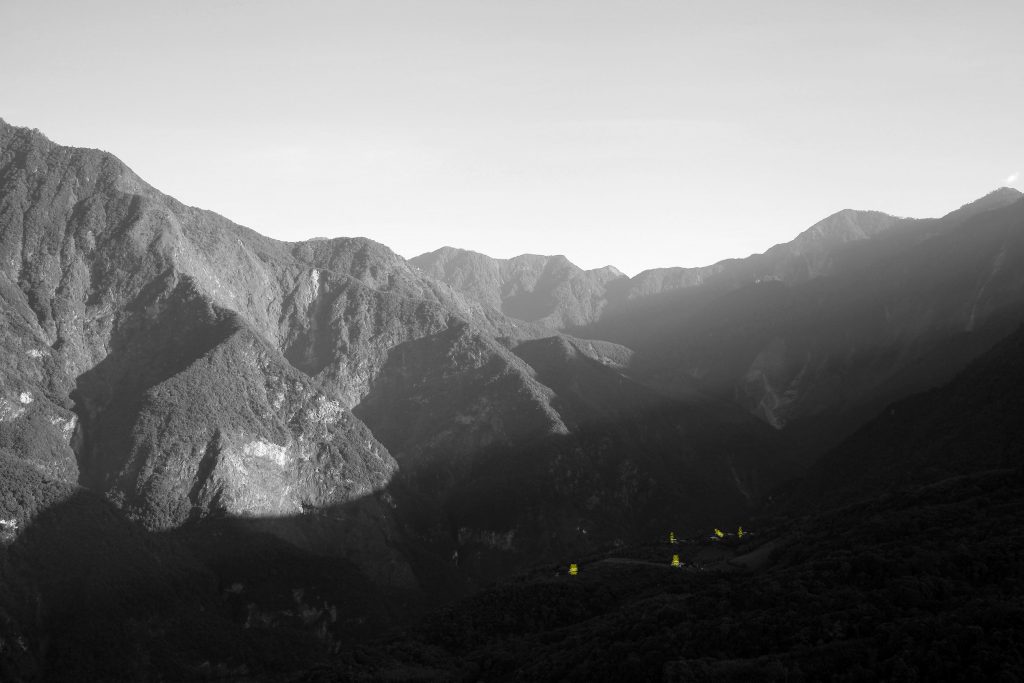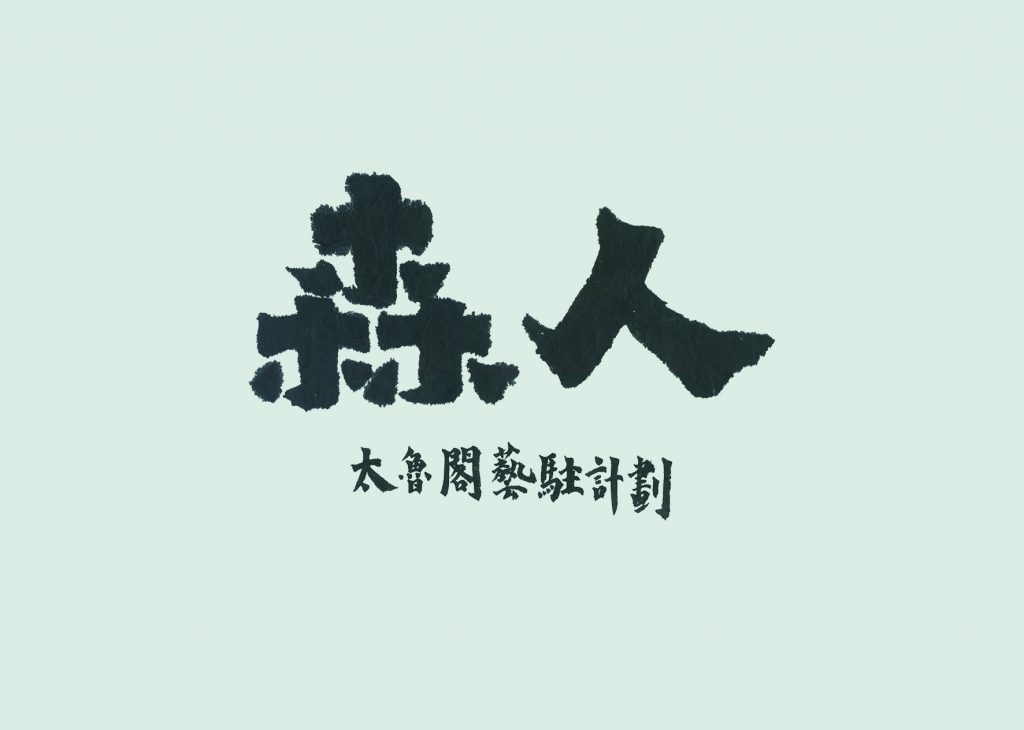 For English, please scroll down.
For English, please scroll down.
展期:2016 年 07 月 16 日至 31 日,週三到週日上午四時至下午七時(TCAC 台北當代藝術中心)、2016 年 07 月31日至 9 月 30 日(大同大禮部落)
台北當代藝術中心開幕:2016 年 07 月 16 日,TCAC 台北當代藝術中心,上午四時
大同大禮部落開幕:2016 年 07 月 31 日,大同大禮部落達道的家,上午四時
地點:TCAC 台北當代藝術中心,台北市保安街 49 巷 11 號(捷運大橋頭站)、大同大禮部落,花蓮縣秀林鄉
藝術家:赤嶺智也、余曉冰、都姆恩、秦政德、黃韶瑩、詹奉宗、 歐靜雲
策展人:陳政道
《森人—太魯閣藝駐計劃》緣起於思考是不是能透過策展實踐,讓藝術工作者進駐國家公園揭示另種人與自然關係,透過藝術家與太魯閣族大同大禮部落居民交流,在國家公園內部落住民與當代藝術社群相逢、疊合與交叉實踐的過程,迴返、思考前述另種人與自然關係的提問。
太魯閣族大同大禮部落位在太魯閣國家公園立霧山上,因至今尚未供給電力所以被稱為黑暗部落。早期政府低價收購原住民在山上的土地,將當時近約五十人的大同大禮部落遷址到立霧溪旁的現代化水泥房,目前僅留小部分族人住居山上。策展人陳政道在2011年陪同荒野保護協會首次走訪大同大禮部落,對山上的生態環境及高齡86歲頭目達道的嘹亮歌聲留下深刻的印象。2015年6月執行計劃《樹之旅》時帶著一米高的氣球小樹前往山上的部落,在第二天準備離開時,阿香阿姨好奇地詢問《樹之旅》表示氣球小樹很美,希望可以留下氣球小樹展示給日後來訪的登山客,當下答應了要求並意外地在回到台北後收到寄自黑暗部落的天然藝術品—花蓮原產玫瑰石一對。自此《樹之旅》變成《石與樹》,也開始對原住民美學及其展覽慾望的思考。
如何透過太魯閣立霧山的自然環境回應當前臺灣面臨的生態問題?法國哲學家費利克斯・瓜塔里(Félix Guattari)曾在著作《三個生態學》(The Three Ecologies, 1990)中提出別於挪威哲學家阿恩·內斯(Arne Næss)深層生態學觀點的生態學哲學,瓜塔里表示:「關於生態學的討論需同時考慮心智生態學、社會生態學以及環境生態學的觀點,而且唯有透過跨領域及哲學意義主體化的過程,我們才有辦法真正的理解此刻真正面臨的自然危機。」藝術面對自然亦然,唯有透過藝術家與部落住民的交流,透過「參與」才有機會在過程中尋獲藝術面對自然生態問題時能可提供的積極意義,進而提供另種自然意義的想像。參與在這邊意義上不同於策展人尼可拉· 布西歐(Nicolas Bourriaud)在《關係美學》中提及的參與—企圖抹除物件意義、強調關係為創作形式的藝術宣言。參與的意義在這更接近瓜塔里的生態哲學觀點—共生(living together),直接回應如何面對自然問題的提問。
余曉冰
關注在「跨文化」(trans-culturalism)的對話及其相關行動,透過創作企圖揭發被隱藏的歷史、被壓抑的記憶、空間和認同的倫理關係和個人與國家之間的無定形關係。近期在創作上聚焦在思考如何透過中國傳統庭院的建置為作一種創作工法,透過「庭院」開啟不同的歷史和文化之間的溝通,以此解繫和再繫我們已明瞭的文化意義及相關知識。
〈庭院保育〉
某次在東柏林郊區意外地發現了一個中國式的庭院,開始對出現「文化限定」(culturally-bound)日常經驗產生的關注。〈庭院保育〉概念來自在發現太魯閣國家公園內大同大禮部落屋主都會在屋外的私人區域種植特定的植栽,也同時聽聞政府因為國家公園自然保育(nature conservation)的需求所以將族人安置到山下居住的故事,於是希望透過〈庭院保育〉提問什麼才是正確的自然培植(cultivation of nature)之道。計畫中將與部落藤藝家都姆恩.馬邵合作,在 TCAC台北當代藝術中心及都姆恩山上竹屋周圍建置庭院,台北展區的植物將以都姆恩期待的植栽及森林公園內亞洲水泥公司生態園區的植物為主,展覽結束後會將台北的植株移植到都姆恩的家作為感謝的贈禮。
地點:TCAC台北當代藝術中心,台北市&都姆恩.馬邵的家,大同部落,太魯閣國家公園,花蓮縣秀林鄉
歐靜雲
以平面繪畫為主要創作的形式,常以神話知識中的宇宙觀、生命中的失落、歡愉的感官經驗與暴力的樣式為創作內容,同時以此作為作品感官視覺上的操作與命題的延伸,最後在創作中再現戰爭、享樂、宗教與人造事物之間關於與一些催情與癲狂的寓意,再思關於羞恥與關於罪惡的一切意義。
〈染料與耶穌〉
與大同部落部落彩虹屋簡大姐聯繫後了解許多關於部落的故事,了解太魯閣族人在處理信仰上,同時保留了他們的祖靈與耶穌,故事中的膽汁發黑的原因來自於與這座山距離遙遠的異文化-罪惡的起源。一直以來,部落的尊嚴、歷史與罪惡都和善的與非部落文化共存著,於是想在〈染料與耶穌〉處理一些關於黑色的事物,就像從部落織染、飲食與生活的經驗中找到一些傳統文化的灰燼,依收集自山上的黑色故事製作一系列關於聖經的插畫,在插畫製作過程中放入部落山上傳統生活中出現的植物汁液混在基底材上,就像那些故事裡燃燒在戰火、地緣、難以力抗生命改變後留存下來的魔法粉末。
地點:TCAC台北當代藝術中心,台北市&彩虹屋,大同部落,太魯閣國家公園,花蓮縣秀林鄉
黃韶瑩
善於透過創作來回應個人生命經驗,透過觀看與閱讀牠者的身體,回應到自身的社會處境及牠者的生命狀態。同時思考身為人存在於社會中的我們,身體會因為環境而產生選擇性的變化,例如意圖符合社會期待樣貌或在身體上建置無形的社會框架等。以各種不同類型關於空間性的創作方式,透過材質與空間結合所產生的厚度,來回應藝術家所看的身體及找尋的另種身體可能的形狀-原初的模樣。
〈此山非彼山〉
在立霧山回程的火車上,看著手機裡的相簿,手指輕快的滑過一張張照片回憶著立霧山的顏色,在這一連串日常的動作下卻形塑了與記憶無法共感的矛盾:不自覺自問為什麼手機的照片無法讓人聯想到身在立霧山當下的真實?於是發現影像的狡獪,因為它編造了斷裂並與真實產生距離。於是在多次來往台北與立霧山的過程中,常思考著是否能利用日常的材料或現成物來呈現個人的生活經驗,並從中尋找立霧山,重現山林的意象,這也是一個讓人重返立霧山的方法,同時與部落共感,從部落建立山友們對於立霧山的意象,也許部落的立霧山才是人們印象中的山,〈此山非彼山〉透過蒐集與重新建構的動作看見你我記憶中的山。
地點:TCAC台北當代藝術中心,台北市&達道的家,太魯閣國家公園,花蓮縣秀林鄉
詹奉宗
自然與人類文明間消長關係為其創作持續發展命題,擅長以 「物質派對」式的雕塑及空間裝置方式創作,從即興拼裝拾得物、現成物及天然素材出發,以直覺方式來探索人類欲望操作下物質的能量流動與生命週期。讓觀者在緩慢沈思與凝視的過程中,建立個人與物質的私密性關係,來反思主流價值觀及資本主義世界無止盡的發展,挖掘被抑制的反動知覺、遊戲性的思維及覺察待被更新的心靈。
〈文明的腳步〉
人類文明是用什麼角度看待大自然?人類所有與大自然的互動是否拉近了人類與自然的距離?進出立霧山多次,每每讓人讚嘆這邊的絕美景色、聽著單純開朗的族人訴說經歷遭逢的變化,思考著也許透過一個呈現大自然本質及貼近部落文化的創作來質疑人類文明在自然裡的活動。發想參展作品過程因每次上山都有不同的體悟,以致計畫構想一直變化,也由於部落傳統生活已不復在,僅能透過與部落居民互動及回到城市生活日常後查閱的資料,驚覺文明的腳步除了可以是巨大的入侵,也可以是亦步亦趨不知不覺地將當地文化發生質變,於是提出一個可以讓人在自然環境中不期而遇慢下腳步來體驗的創作-〈文明的腳步〉。
地點:大同部落,太魯閣國家公園,花蓮縣秀林鄉
秦政德
朋友們叫他「阿德」,當年「文化美術系事件」的關鍵人物,也因文大事件創立與同學共同創立「小草藝術學院」工作室,自許為永遠的「小草 N 號志工」,藝術學院長年持續以在台灣歷史文物中發現的圖像為載體製作明信片。除了台灣歷史文件的收藏,在藝術創作的方法學上發展出極具個人特色的地理學田野工法,透過立碑的行動揭示及再現被人忽略及被宏大敘事遺忘的重要台灣歷史片段。
〈魯閣太魂 ─ 太魯閣族人捍守家園犧牲永記〉&〈立霧峽靈 ─ 一九一O年代太魯閣戰爭殤魂碑〉
2015年夏的錐麓古道行,震懾於太魯閣峽的景觀,也難忘途中的日警持館代五郎之碑。隨後又在李崠、大混山隘勇線碰到渡邊要之墓,忍不住對自己提出了創作提問:「相對屢屢見到的日人遇難碑,為什麼沒有被侵入家園、憤而抵抗的原住民犧牲紀念碑呢?難道真是成王敗寇?歷史詮釋權始終掌握在強勢者?無法翻轉?或者只是我們一直遺忘、沒有行動?」因此這次的計畫,除了是回應自我創作提問,也是對百年前太魯閣戰爭中犧牲的族人之永念、不忘……
地點:TCAC台北當代藝術中心,台北市&大同部落,太魯閣國家公園,花蓮縣秀林鄉
《森人—太魯閣藝駐計劃》為「2015開放策展學校」策展人展覽發表提案之獲選計畫。
本計劃由文化部補助與支持。
特別感謝 TCAC 台北當代藝術中心及台灣文化產業學會。
Time: 2016.07.16-30, Wed – Sat, 4am-7pm (TCAC), 2016.07.30-9.30 (Datong and Dali)
Venue: Taipei Contemporary Art Center, No. 11, Lane 49 Baoan Street, Taipei (MRT: Daqiaotou Station)& Datong and Dali, Taroko National Park, Hualien
Opening at TCAC: 2016.07.16, TCAC Taipei Contemporary Art Center, 4am
Opening at Datong and Dali: 2016.07.31, Datong and Dali, 4am
Artists: Tomoya Akamine, Cheng-Te Chin, Feng-Tsung Chan, Masow Dumuan, Shao-Ying Huang, Candice Jee, Jing-Yun Ou
Curator: Cheng-Tao Chen
“Tree Tree Tree Person — Taroko Arts Residency Project” considers the possibility of practicing contemporary curatorial research from a specific location in one of Taiwan’s National Parks. The project aims to define an alternative imagination of nature, and through a process of co-operation between artists, curator and local residents to redefine relationships between people, environment and artistic practices. The exhibition at TCAC brings an urban ecology into dialogue with these elements.
The locations of the curatorial base in Taroko National Park, Datong and Dali, are called dark villages, because they have no electricity supply. Many years ago, Taiwan’s government claimed the area as a national park, forcing local aboriginal communities to migrate to the modern cement houses built at the foot of the mountain. Today only a small percentage of the aboriginal people continue to own their ancestral homes on the mountain. In 2011, curator Cheng-Tao visited Datong with the Society of Wilderness, and was impressed by both the complexity of its mountain ecology and the tribal leader’s loud, clear singing voice. In 2015, he returned to Datong, bringing with him his artistic project “Tree’s Journey”. He met an aboriginal woman who requested Cheng-Tao to leave “Tree’s Journey” with the tribe so it could be exhibited for future visitors. In exchange, Cheng-Tao was surprised to be given a pair of rose stones in appreciation from the tribe. Subsequently, “Tree’s Journey” was renamed “Stone and Tree”. This experience inspired Cheng-Tao to think about aboriginal people’s aesthetics, and their desire to have an exhibition.
How can we apply the practice of curatorial research in a national park to explore imaginations about the relationship between humans and nature? How should we consider ecology when thinking about the natural environment? In Félix Guattari’s The Three Ecologies it states that we need to consider the mental, the social and the environmental in order to fully realize the definition of nature. Only through trans-disciplinarity and the philosophical process of subjectivity can we think about the crisis ecology faces today. The same conditions apply when art meets nature. It is only through participation – the co-operation between artists and aboriginal community – that positive concepts of nature and the ecology can be generated through art. The definition of participation here is different from that of Nicolas Bourriaud’s relational aesthetics, where he declares it as an artistic form that attempts to resist the artwork as object. Instead, this idea of participation is closely related with Guattari’s views on ‘living together’ in direct response to questions about nature.
Extending the discussion of ‘living together’ and the ‘ecology of institutional critique’, the curator creates a dialogue between the distinct sites of TCAC Taipei Contemporary Art Center and the Taroko National Park curatorial base, displacing the artists’ projects and audience between the two spaces. In addition, in following with the concept of ‘living together’, the two different lifestyles of these sites will converge through combining the time of the tribal daily schedule with that of the exhibition space. TCAC will open at 4am, with a complimentary drink served to guests in the first six hours every day. During the period of the exhibition, there are four workshops (7/23, 7/24, 7/30, 7/31) and a tour kicking off the part of the exhibition that takes place in the National Park (7/30-31) . Anyone who is interested to travel to the curatorial base is welcome. As places are limited, please feel free for registration.
Candice Jee
Candice Jee’s practice concerns dialogues around trans-culturalism and its related actions, attempting to expose hidden histories, repressed memories, the connection of space with identity, and the amorphous relation between the individual and the state. She currently is thinking about how to apply the idea of the Chinese garden as an artistic form in order to open communication between different histories and cultures, untangling and entangling what constitutes notions of culture and cultural belonging.
Garden Conservation
The experience of accidentally discovering a Chinese-style garden in a former-East Berlin suburb inspired Candice Jee to begin questioning the idea of the “culturally-bound”, concerning the transportation of objects to a completely different place far from their previous environment. The project idea of “Garden Conservation” came from thinking about the notion of the conservation of nature. “Nature” can be defined as the environment that is grown by the tribe people on their private land. However, in the national park, nature has been identified as the state of the environment without any previous trace of human activities. In this project, I will co-operate with Masow Dumuan and establish two gardens in TCAC Taipei Contemporary Art Center and Dumuan’s house. The plants grown in the the space of TCAC will be transported to Dumuan’s house after the period of the exhibition, as a gift of gratitude for the cooperation.
Venue: Taipei Contemporary Art Center, No. 11, Lane 49 Baoan Street, Taipei (MRT: Daqiaotou Station)& Datong and Dali, Taroko National Park, Hualien
Jing-Yun Ou
Jing-Yun Ou applies painting as his main creative form. He often draws on mythical narratives of loss, joy, the sensual and the universe as his creative resource. These serve as creative methodologies through which he produces violent content, extending these notions into the medium of painting and the creation of sensory visual works. In his work can be perceived representations of war, pleasure, religion and the mania of the human condition, with some aphrodisiac and intent to influence the viewer to think about the meaning of shame and notions of evil.
Dyes and Jesus
After contact with the Rainbow House owner, Jing-Yun Ou realizes that the tribe people believe in their ancestral spirits and Jesus at the same time. Also, finding out about black bile in a tribal story, he relates this with a distant outside culture – the origins of evil. For a long period of time, tribal honour has consisted of both good and evil histories, and non-tribal cultures, simultaneously co-existing. For this reason, Jing-Yun wants to paint some stories about darkness, as seen for example in the tribal weaving and dyeing practices, diets and life experiences. The result will be a series of illustrations about the Bible, using plant juices mixed with painting material. The juice acts as the symbol for a magic powder that was found in a historical tribal war, tribal geopolitics, and the tribe’s difficulty to change their living conditions.
Venue: Taipei Contemporary Art Center, No. 11, Lane 49 Baoan Street, Taipei (MRT: Daqiaotou Station)& Datong and Dali, Taroko National Park, Hualien
Shao-Ting Huang
Shao-Ying Huang’s work involves her creative response to personal experiences. She frequently enacts the method of watching the bodies of others, which initiates her thoughts upon living conditions. Moreover, the visitors are forced to consider how the human being prepares themselves in order to live in our society. For example, people habitually change their appearance and intentions to comply with social expectations. After extended artistic research, through spatial creative practice, she often applies a variety of different ways to respond to what she sees behind the physical body, meanwhile looking for another kind of possible shape – the original appearance.
This Mountain nor That Mountain
On the way back to Taipei, when Shao-Ying Huang looked at her photo album in her phone, she thought about the gap between these images and the real environment. It was difficult for her to connect her physically vivid experiences of Liwu Mountain with the photographs. She began to interrogate the way that these images are disconnected from her memory. After visiting the tribe many times, she implements the project “This Mountain Nor That Mountain” to bring this question to the audience. She wishes to use objects from her daily life to represent her personal experiences in this project, describing the process in which she tries to imagine the nature of the mountain. In the end, it could be the most faithful way to approach Liwu Mountain and to represent the tribe. Recreating the image of nature from her experiences with the tribe could represent the real nature that she remembered.
Venue: Taipei Contemporary Art Center, No. 11, Lane 49 Baoan Street, Taipei (MRT: Daqiaotou Station)& Datong and Dali, Taroko National Park, Hualien
Feng-Tsung Chan
Feng-Tsung Chan develops his artistic concerns upon the long-term relation between nature and human civilization. In particular, his artistic works of sculpture and installation come together to form a “material party” – an assembly of found objects, the ready-made and natural materials. Through this, he uses intuitive means to explore the human desires that operate within the material flow of energy and the life cycle. In the reception of his work, he wishes that his viewers engage in a slow process of contemplation, establishing a private relationship between the individual and the physical. This reflects the mainstream values in our world of capital and endless development. Ultimately, the work provides a chance for us to become aware of our habitual reactions, triggering a game with our thoughts, and a willingness for their renewal.
The Pace of Civilization
How does human civilisation perceive nature? Do all interactions between humans and nature serve to narrow the distance between us? Visiting Liwu Mountain many times, Feng-Tsung Chan is always affected by the diverse and beautiful views that he sees there. Hearing the tribe people’s stories, he wishes to create a project which he will present within that environment, to question the human activity that takes place within the national park. In the beginning, he felt it was difficult to come up with a proposal for this project, especially when he had only a minimal number of living experiences with the tribe. Regarding this point, he realised that urban culture not only impacts nature in sudden encounters, but also influences the tribe gradually. Subsequently, his artistic project will encounter people unexpectedly in the natural environment, and is named “The Pace of Civilization”.
Venue: Datong and Dali, Taroko National Park, Hualien
Cheng-Te Chin
Friends call him “A-de”, and he was also a key figure in the historical event of the Department of Fine Art in the Chinese Culture University. During this period, he and his classmates established the studio “Grass Arts Academy”. The studio continues the practice of producing postcards, printed with traditional images found within Taiwan’s historical documents. Apart from his collection of Taiwan’s historical documentation, he also developed his artistic methodology through geographical fieldwork techniques. Though the performance of erecting stones in the field, his artistic project reveals important elements of historical events that Taiwanese people tend to ignore.
Monument
The idea of this project comes from the question of ethnic equality in Cheng-Te Chin’s previous hiking experiences. He still remembers the summer of 2015, when he took the Zhuilu Old Road, in awe of the natural landscape of Taroko Gorge. At that time, he noticed the monuments commemorating the leader of the Japanese army there, and realized that the narrative of history is always made by those in power. He began to question his agency or ignorance when confronting this condition, and the choices he had surrounding its change. In raising the project of the monument, Cheng-Te tries to reveal these questions publicly, shedding light on the fragments of historical events that people forget.
Venue: Taipei Contemporary Art Center, No. 11, Lane 49 Baoan Street, Taipei (MRT: Daqiaotou Station)& Datong and Dali, Taroko National Park, Hualien
“Tree Tree Tree Person — Taroko Arts Residency Project” is the selected exhibition proposal from TCAC’s 2015 Curatorial School.
Sponsored by Ministry of Culture
Special thanks to Taipei Contemporary Art Center

